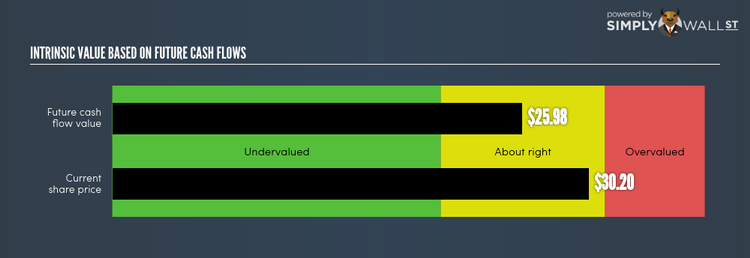Is Simmons First National Corporation (NASDAQ:SFNC) Expensive For A Reason? A Look At The Intrinsic Value

Valuing SFNC, a bank stock, can be daunting since these financial companies have cash flows that are impacted by regulations that are not imposed upon other industries. Banks, for example, must hold certain levels of tiered capital in order to maintain a safe cash cushion. Emphasizing elements like book values, as well as the return and cost of equity, is beneficial for assessing SFNC’s valuation. Today we will look at how to value SFNC in a reasonably accurate and easy approach. View our latest analysis for Simmons First National
Why Excess Return Model?
Before we begin, remember that financial stocks differ in terms of regulation and balance sheet composition. SFNC operates in United States which has stringent financial regulations. In addition to this, banks tend to not hold significant amounts of physical assets on their balance sheet. As traditional valuation models put weight on inputs such as capex and depreciation, which is less meaningful for finacial firms, the Excess Return model places importance on forecasting stable earnings and book values.
The Calculation
The central assumption for Excess Returns is, the value of the company is how much money it can generate from its current level of equity capital, in excess of the cost of that capital. The returns above the cost of equity is known as excess returns:
Excess Return Per Share = (Stable Return On Equity – Cost Of Equity) (Book Value Of Equity Per Share)
= (10.17% – 9.92%) * $25.13 = $0.06
We use this value to calculate the terminal value of the company, which is how much we expect the company to continue to earn every year, forever. This is a common component of discounted cash flow models:
Terminal Value Per Share = Excess Return Per Share / (Cost of Equity – Expected Growth Rate)
= $0.06 / (9.92% – 2.47%) = $0.85
Putting this all together, we get the value of SFNC’s share:
Value Per Share = Book Value of Equity Per Share + Terminal Value Per Share
= $25.13 + $0.85 = $25.98
Compared to the current share price of $30.2, SFNC is , at this time, priced in-line with its intrinsic value. This means SFNC isn’t an attractive buy right now. Valuation is only one side of the coin when you’re looking to invest, or sell, SFNC. There are other important factors to keep in mind when assessing whether SFNC is the right investment in your portfolio.
Next Steps:
For banks, there are three key aspects you should look at:
Financial health: Does it have a healthy balance sheet? Take a look at our free bank analysis with six simple checks on things like bad loans and customer deposits.
Future earnings: What does the market think of SFNC going forward? Our analyst growth expectation chart helps visualize SFNC’s growth potential over the upcoming years.
Dividends: Most people buy financial stocks for their healthy and stable dividends. Check out whether SFNC is a dividend Rockstar with our historical and future dividend analysis.
For more details and sources, take a look at our full calculation on SFNC here.
To help readers see pass the short term volatility of the financial market, we aim to bring you a long-term focused research analysis purely driven by fundamental data. Note that our analysis does not factor in the latest price sensitive company announcements.
The author is an independent contributor and at the time of publication had no position in the stocks mentioned.

